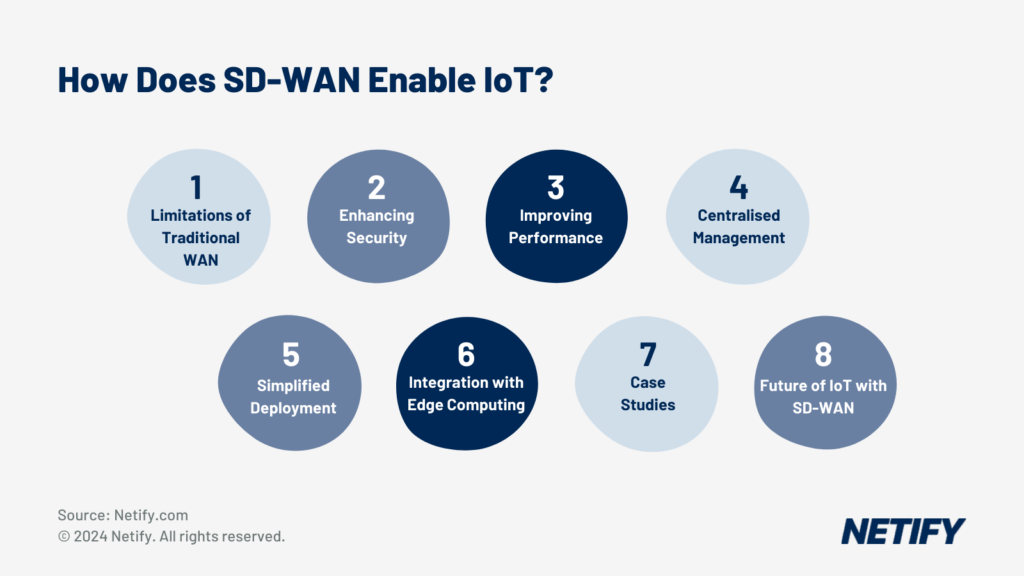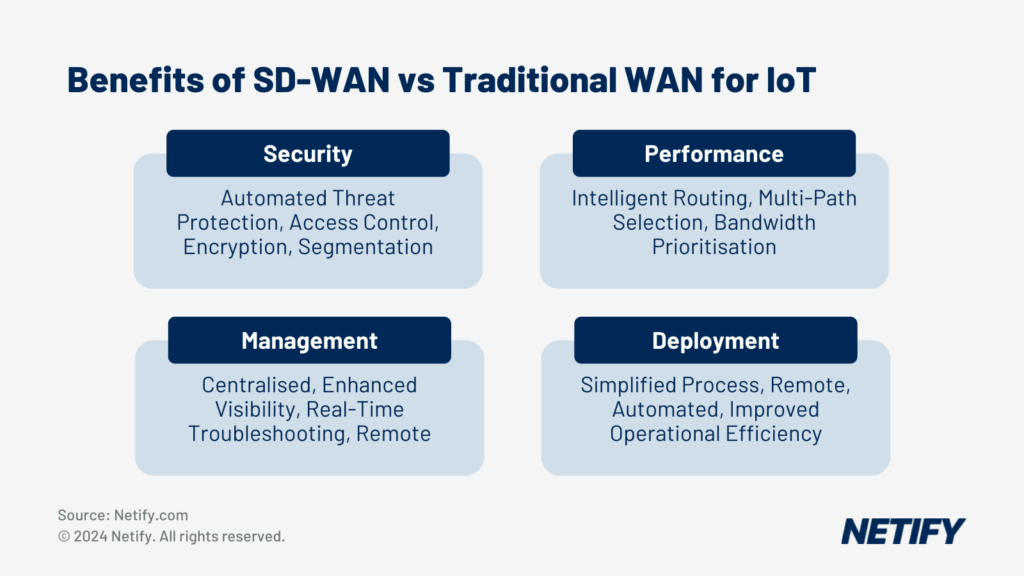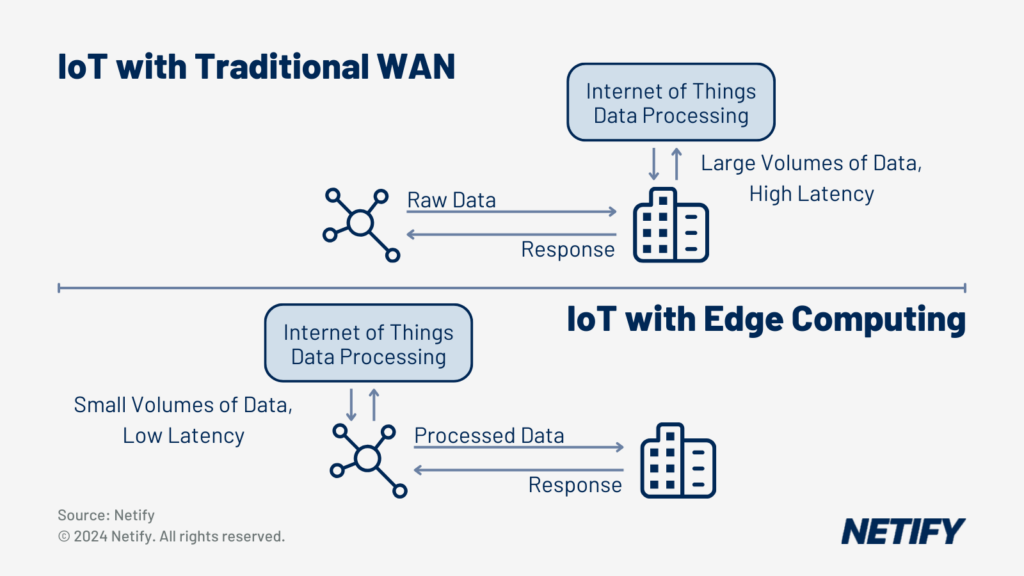| SD-WAN enhances IoT by improving security, performance, scalability, and simplifying deployment, enabling seamless integration of growing device networks. |

Since the start of the 2010s, there has been a growing demand for Internet of Things (IoT) devices and integrations. IoT devices, often coming in the form of sensors and smart devices have changed computing by using vast amounts of data in order to convert analysis of the real-world into digitised formats. This facilitates a data-based approach for businesses to monitor and improve real-world practices, such as predicting break down of production lines in manufacturing.
However, given that IoT devices generate a lot of data, this can be overwhelming for many businesses networks without the proper network infrastructure in place. The best solution for networking IoT devices is Software-Defined Wide Area Network (SD-WAN) solutions. Not only does SD-WAN improve the performance and security of networks, SD-WAN also offers many other benefits for businesses integrating IoT.
Before considering the benefits of SD-WAN for IoT, it’s important to first understand the limiting factors of traditional WAN networks. These networks typically lack flexibility in configurations, requiring manual work to change and given IoT networks often grow and change, this limits operational efficiency.
Further to this, traditional WAN networks usually backhaul data to a centralised data centre, introducing high latency in communications, which prevents real-time IoT data processing.
Finally, traditional WAN far outdates IoT and this can be seen by how traditional WAN isn’t designed for distributed IoT networks. The lack of security for the network edge means that IoT devices are particularly vulnerable to attacks such as device spoofing and data interception.

The benefits of using SD-WAN for Internet of Things (IoT)
Enhancing IoT Security with SD-WAN
Unlike traditional WAN, SD-WAN solutions offer many benefits to network security, with automated threat capabilities providing businesses with protection to their IoT devices, without increasing manual workload for network administrators. Access control functionality provided by SD-WAN also ensures that IoT traffic remains privatised and secures sensor information.
Within healthcare and finance industries, the security benefits of SD-WAN are especially important as these assist with ensuring that IoT traffic meets regulatory compliance and data protection. Features such as end-to-end encryption and segmentation to isolate and obfuscate IoT traffic can be crucial for HIPAA in healthcare and PCI DSS in finance settings.
Improving IoT Network Performance and Scalability
Improvements from SD-WAN aren’t limited to security though, with network performance also benefitting. Intelligent routing integrations means that SD-WAN can leverage multiple network paths, switching between the best available routes to ensure bandwidth availability for uninterrupted communications. This is an essential feature for businesses wanting to prioritise critical IoT data, minimising the lag and disruption these communications experience.
These integrations also mean that SD-WAN allows scalability of IoT integrated networks, enabling devices to be added to the network with no performance degradation and no further large networking costs in order to accommodate growth.
Centralising IoT Network Management
A growing network typically results in a network dispersed across multiple locations, which can decrease operational efficiency when managing devices. SD-WAN offers enhanced visibility into network traffic through telemetry, with a centralised management pane for monitoring and control of the network all in one location. This enables businesses to troubleshoot any issues with network connections in real-time. Improved connections can equate to optimised operations across multiple locations and allows for remote management, reducing strain on network administrator teams.
Simplifying IoT Deployment
The centralised management offered by SD-WAN also enables simplified IoT deployment. As SD-WAN can be configured remotely, this means that new network edges with IoT devices can be quickly setup and brought online to improve operational efficiency, reduce complexity and improve overall scalability to meet business objectives.
Integration with Edge Computing

Differences in data processing and network load for Internet of Things (IoT) integrations with SD-WAN and Traditional WAN
In order to maximise Internet of Things integrations, businesses should also look to utilise Edge computing features within SD-WAN solutions, such as those offered by VMware, HPE (Aruba) and Palo Alto Networks. Edge computing moves the processing of data to the originating source, reducing the volume of traffic being transferred across the network, thus reducing latency, freeing up bandwidth from being used and improving the reliability of real-time data processing.
Case Studies
In one case study, a manufacturing business implemented SD-WAN in order to improve their network’s performance. The manufacturer noted a 30% reduction in their network costs and a significant improvement to the performance and reliability of their business-critical applications. One of the benefits they had not accounted for was the enhanced operational efficiency due to the improvements for Internet of Things integrations.
The Future of IoT with SD-WAN
The integration of Artificial Intelligence (AI) and Machine Learning (ML) has allowed SD-WAN solutions to improve the automation of network management processes, by enabling predictive analysis of network conditions and telemetry. This means that the setup and management of new IoT networks does not significantly increase network administrators workloads, whilst improving network performance.
Conclusion
SD-WAN not only improves the security, performance and scalability of networks but prepares businesses to adapt to growing Internet of Things demands. With SD-WAN expected to increasingly support IoT, the benefits of improved operational efficiency and security will benefit these technologies, especially across global networks or settings with rigorous regulatory compliance.


